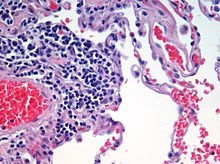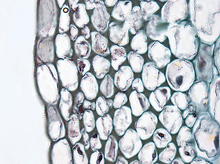Tissue (biology)
Animal tissues
Connective tissue
Muscular tissue
Nervous tissue
Epithelial tissue
- The cells of the body's surface form the outer layer of skin.
- Inside the body, epithelial cells form the lining of the mouth and alimentary canal and protect these organs.
- Epithelial tissues help in absorption of water and nutrients.
- Epithelial tissues help in elimination of waste.
- Epithelial tissues secrete enzymes and/or hormones in the form of glands.
- Some epithelial tissue perform secretory functions. they secrete a variety of substance such as sweat,saliva(mucus),enzymes,etc.
- Simple squamous epithelium
- Stratified squamous epithelium
- Simple cuboidal epithelium
- Transitional epithelium
- Pseudostratified columnar epithelium (also known as Ciliated columnar epithelium)
- Columnar epithelium
- Glandular epithelium
- Ciliated columnar epithelium
Plant tissues
- Epidermis - Cells forming the outer surface of the leaves and of the young plant body.
- Vascular tissue - The primary components of vascular tissue are the xylem and phloem. These transport fluids and nutrients internally.
- Ground tissue - Ground tissue is less differentiated than other tissues. Ground tissue manufactures nutrients by photosynthesis and stores reserve nutrients.
Meristematic tissues
- Apical Meristem - It is present at the growing tips of stems and roots and increases the length of the stem and root. They form growing parts at the apices of roots and stems and are responsible for increase in length, also called primary growth. This meristem is responsible for the linear growth of an organ.
- Lateral Meristem
- - This meristem consist of cells which mainly divide in one plane and cause the organ to increase in diameter and growth. Lateral meristem usually occurs beneath the bark of the tree in the form of Cork Cambium and in vascular bundles of dicots in the form of vascular cambium. The activity of this cambium results in the formation of secondary growth.
- Intercalary Meristem - This meristem is located in between permanent tissues. It is usually present at the base of node, inter node and on leaf base. They are responsible for growth in length of the plant and increasing the size of the internode, They result in branch formation and growth.
Permanent tissues
Simple tissues[edit]
Parenchyma[edit]
Collenchyma[edit]
Sclerenchyma[edit]
Epidermis[edit]
Complex permanent tissue[edit]
Xylem[edit]
Phloem[edit]
Mineralized tissues
History of the concept[edit]
©Aah.Towfiq
®Atps.Plus™call:- +8801978698786













Comments
Post a Comment
Here all information related to medical and doctoral health is published. Visit any of these languages in your language to see your language.